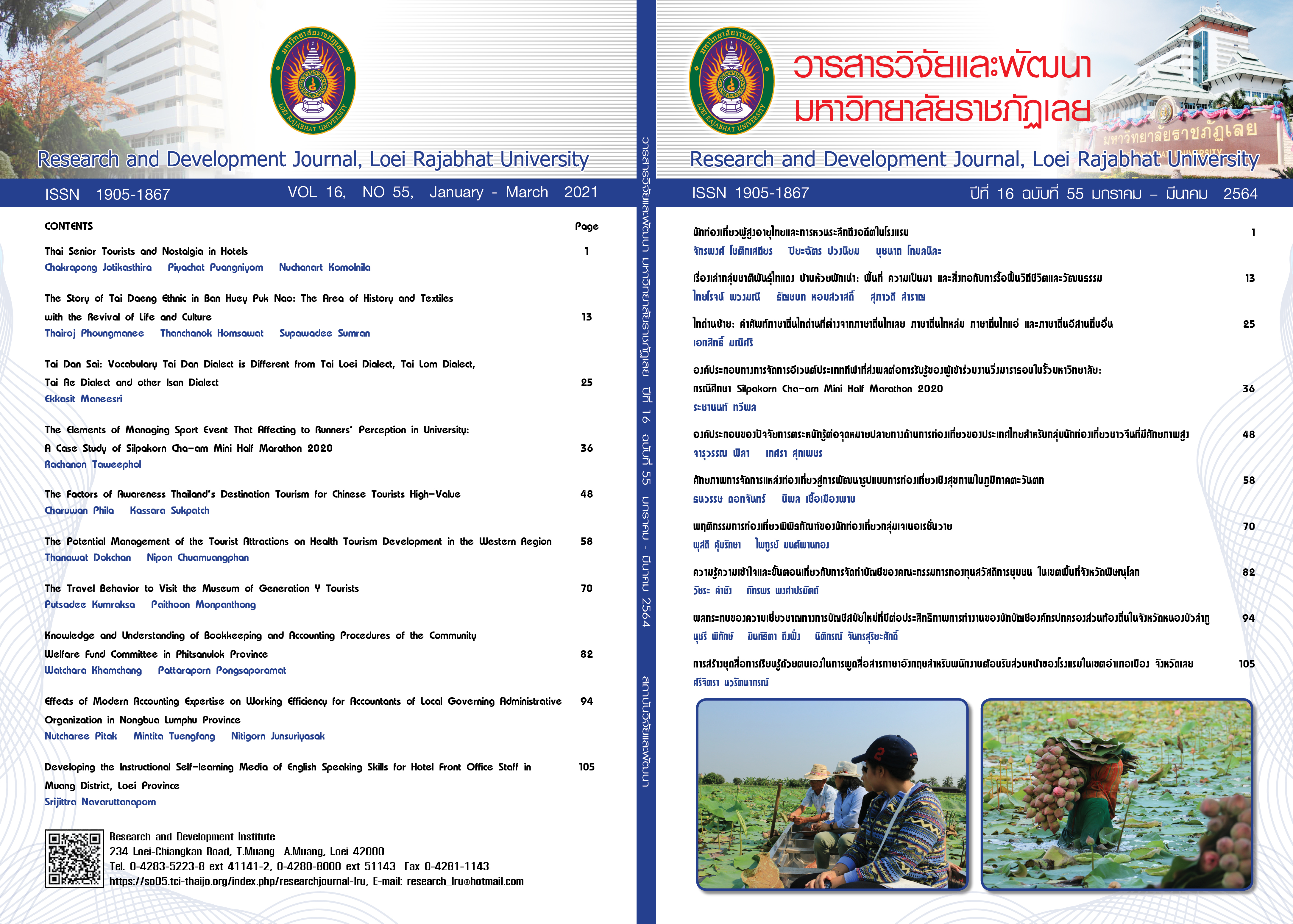The Story of Tai Daeng Ethnic in Ban Huai Phak Nowe: The Area of History and Textiles with the Revival of Life and Culture
Keywords:
revival, lifestyle and culture, Tai Daeng ethics, Ban Huai Phak NoweAbstract
This academic article was aimed to study about the area, history and textiles with the revival of life and culture of Tai Daeng Ethnic group in Ban Huai Phak Nowe, Phurau district, Loei province. The data was collected from the document, interview and focus group conversation in Ban Huai Phak Nowe village, Phurau district, Loei province. Theoretical concept of cultural preservation was applied for this study and content analysis was used for analyzing data. The results of the study showed that there were evidences from old people still living in the area and photographs of the ancestors enhancing new generations to realize and become interested in reviving traditional lifestyle through the status of being local people immigrating to settle down in this area from the past to present which was connected to people outside communities by collecting the data and develop the area of Ban Huai Phak Nowe to have Tai Daeng Ethnicity. The guidelines for reviving processes were 1) the community leaders should hold the meeting to inform and ask for villagers’ opinion, 2) the community leaders should connect with government sectors to inform and ask for reviving budget, 3) there should be the coordination with education institutes for data collection, and 4) the community leaders and the related organizations should be involved in the operating system and take part in making decision to find out how to start the operation in order to indicate the identity through mediums or object in the area.
References
จินตนา แปบดิบ. (2554). วาทกรรมอัตลักษณ์ไทใหญ่ชุมชนบ้านเมาะหลวง ตำบลแม่เมาะ อำเภอแม่เมาะ จังหวัดลำปาง. วารสารมนุษยศาสตร์และสังคมศาสตร์ มหาวิทยาลัยพะเยา, 1(2), 1-10.
สมพาวัน แก้วบุดตา. (2556). “จาว”: สายสัมพันธ์ฉันท์เครือญาติของไทแดง. วารสารศิลปกรรมศาสตร์มหาวิทยาลัยขอนแก่น, 5(1), 1-22.
สุมิตร ปิติพัฒน์. (2546). คนไทแดงในแขวงหัวพัน สาธารณรัฐประชาธิปไตยประชาชนลาว. กรุงเทพฯ: สถาบันไทยคดีศึกษา มหาวิทยาลัยธรรมศาสตร์.
โศรยา ธัญญประกอบ และปฐม หงส์สุวรรณ. (2560). ตำนานเมืองของคนไทเลยกับปฏิบัติการทางสังคมว่าด้วยสำนึกทางชาติพันธุ์. วารสารมนุษยศาสตร์และสังคมศาสตร์ มหาวิทยาลัยอุบลราชธานี. 8(1), 122-154.
มัญชรี โชติรสฐิติ. (2556). การปรับตัวข้ามวัฒนธรรมของนักเรียนไทยในต่างประเทศ (วิทยานิพนธ์ศิลปศาสตรมหาบัณฑิต). สถาบันบัณฑิตพัฒนบริหารศาสตร์, กรุงเทพฯ.
ไพฑูรย์ มีกุศล. (2559). ประวัติศาสตร์ชาติพันธุ์อนุภูมิภาคลุ่มแม่น้ำโขง. วารสารราชภัฏสุราษฎร์ธานี, 3(2), 1-32.
เพชรรี รูปะวิเชตร์. (2550). การเรียนรู้ลักษณะการจัดการ: การจัดการข้ามวัฒนธรรม. เชียงใหม่: นพบุรีการพิมพ์.
นภาพร อัศวะรังสีกุล. (2562). ปัญหาของกลุ่มชาติพันธุ์ในประเทศไทย: อัตลักษณ์ทางวัฒนธรรมที่เปลี่ยนแปลง. บทความนำเสนองานประชุมวิชาการระดับชาติ มหาวิทยาลัยรังสิตประจำปี 2562, 947-957.
ราชันย์ นิลวรรณาภา. (2557). วิถีวัฒนธรรมการแต่งกายและอาหารกลุ่มชาติพันธุ์ไทแดง. วารสารวิชาการแพรวากาฬสินธุ์ มหาวิทยาลัยราชภัฏกาฬสินธุ์, 1(1), 109-123.
ศิริพร เชิดดอก และจักรพันธ์ ขัดชุ่มแสง. (2558). งานบุญอีสานกับการปรับเปลี่ยนอัตลักษณ์ทางชาติพันธุ์ของชาวไทยเชื้อสายเขมร ในจังหวัดสุรินทร์. บทความนำเสนอการจัดประชุมวิชาการเสนอผลงานวิจัยระดับบัณฑิตศึกษา ครั้งที่ 34. ณ ห้องประชุมมอดินแดง ชั้น 1 อาคารเรียนรวม คณะแพทย์ศาสตร์ มหาวิทยาลัย ขอนแก่น, 1507-1517.
อัจฉริยา. (2557, 5 มิถุนายน). ไปคุยกับผู้ไทแดง-ไทขาวที่แทงฮว๋า เวียดนาม: ชื่อไทแดงมาจากไหน ใครเรียก ใครยอมรับ. สืบค้นจาก https://blogazine.pub/blogs/achariyach/post/5336
Downloads
Published
How to Cite
Issue
Section
License
ข้อความที่ปรากฎในวารสารฉบับนี้เป็นความคิดเห็นของผู้เขียนแต่ละท่าน สถาบันวิจัยและพัฒนา มหาวิทยาลัยราชภัฏเลย และกองบรรณาธิการ ไม่จำเป็นต้องเห็นด้วยและไม่มีส่วนรับผิดชอบใดๆ
สถาบันวิจัยและพัฒนา มหาวิทยาลัยราชภัฏเลย ขอให้ผู้อ่านอ้างอิงในกรณีที่ท่านคัดลอกเนื้อหาบทความในวารสารฉบับนี้






